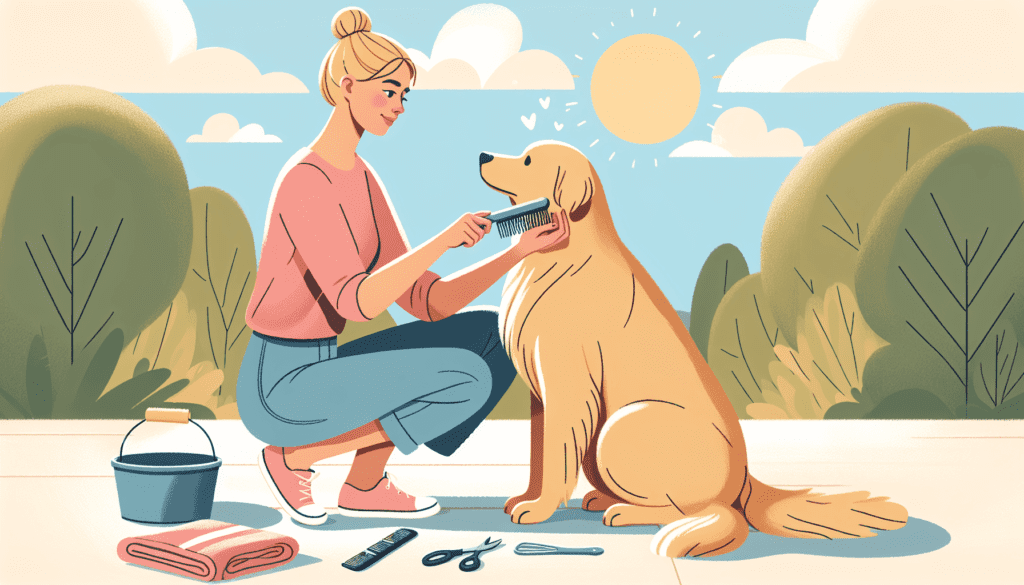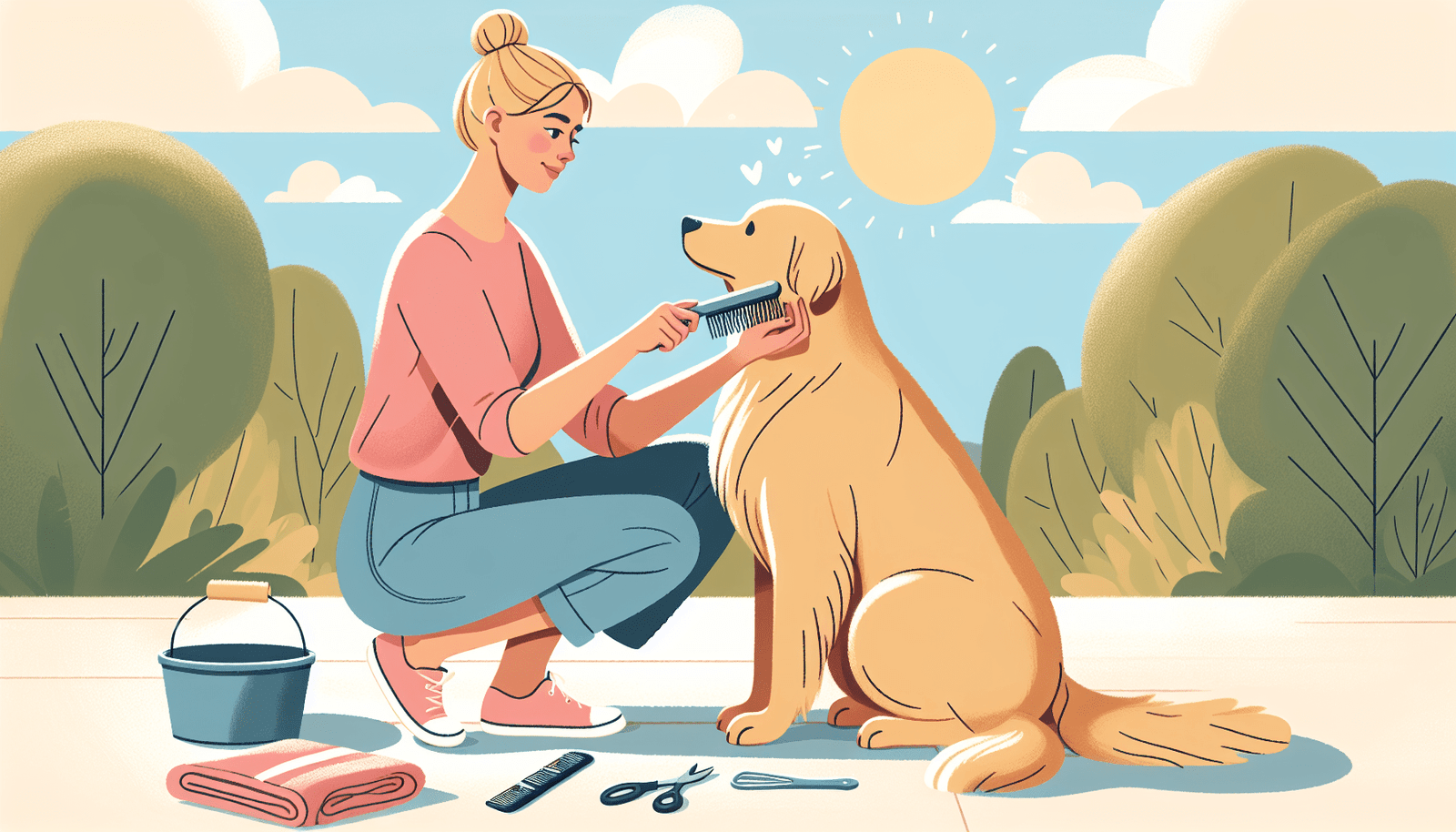If grooming sessions with your dog leave both of you feeling stressed and anxious, you’re not alone. Many pet owners struggle with finding ways to make these sessions more comfortable for their furry friends. But fret not! In this article, we’ll explore some simple yet effective strategies that can help you create a soothing and enjoyable experience for your dog during grooming sessions. From establishing a positive association with grooming tools to providing comforting reassurance, we’ve got your back when it comes to pampering your pup.
Understanding Your Dog’s Needs
Grooming can be a stressful experience for many dogs, so it’s important to understand their needs and fears to make the process as comfortable as possible for them. Take the time to recognize their triggers and fears, such as loud noises, unfamiliar objects, or certain handling techniques. By knowing what makes your dog uncomfortable, you can take steps to minimize these triggers and create a positive grooming environment.
Recognize their fears and triggers
Every dog is unique, so it’s essential to pay attention to their individual fears and triggers. Some dogs may be frightened by the noise of clippers, while others may have a negative association with water. By observing your dog’s reactions and body language, you can identify what specific elements of grooming cause them distress. This understanding will help you tailor your approach to make the experience more enjoyable for your furry friend.
Create a positive association with grooming
One way to help your dog feel more comfortable during grooming sessions is to create positive associations. This means that you should pair the grooming activities with something enjoyable for your dog, such as treats, praise, or playtime. By doing so, you can help your dog associate grooming with positive experiences, which will make them more relaxed and cooperative during future sessions.
Gradually introduce grooming activities
If your dog is particularly fearful or anxious about grooming, it’s important to introduce the activities gradually. Start by simply getting them used to being touched or handled in a gentle and positive manner. Once they feel comfortable with this, gradually introduce grooming tools, such as brushes or combs, making sure to associate them with positive experiences. Taking small steps and giving your dog time to adjust will help build their confidence and reduce any anxiety they may feel.
Preparing the Grooming Environment
Creating a calm and relaxing environment is crucial for ensuring a positive grooming experience for your dog. Here are some key considerations when preparing the grooming space:
Choose a quiet and calm space
Select a location in your home where your dog feels safe and comfortable. Avoid areas with a lot of noise or distractions, as this can add to their stress levels. Ideally, choose a quiet room or corner where you can focus on the grooming process without interruptions.
Use non-slip mats or towels
To prevent your dog from slipping or sliding during grooming, use non-slip mats or towels on the floor surface. This will provide stability and comfort, allowing your dog to feel more secure during the grooming process.
Ensure proper lighting
Good lighting is essential for grooming, as it allows you to see clearly and work with precision. Make sure the grooming area is well-lit, either with natural light or by using appropriate lighting fixtures. This will not only help you perform grooming tasks effectively but also help create a positive and welcoming atmosphere for your dog.

Selecting the Right Tools and Products
Using the right grooming tools and products is essential for your dog’s comfort and well-being. Here’s what you should consider when selecting them:
Research and choose appropriate grooming tools
Different dogs have different grooming needs, so it’s important to research and choose grooming tools that are suitable for your dog’s breed and coat type. Brushes, combs, nail clippers, and other grooming tools come in various shapes, sizes, and materials. By selecting the right tools, you can ensure that the grooming process is as gentle and effective as possible.
Use gentle and dog-friendly grooming products
When it comes to grooming products, opt for those that are specifically formulated for dogs. These products are designed to be gentle on your dog’s skin and coat, reducing the risk of irritation or discomfort. Avoid using human shampoos or soaps, as they may contain harsh ingredients that can be harmful to your dog.
Consider using positive reinforcement tools
Positive reinforcement tools, such as clickers or treat dispensers, can be helpful during grooming sessions. These tools allow you to reward your dog for their cooperation and good behavior, reinforcing positive associations with grooming. Before using any tools, make sure to familiarize yourself with the proper techniques and consult with a professional if needed.
Establishing a Routine
Dogs thrive on routine, so establishing a consistent grooming schedule is beneficial for their well-being. Here’s why a routine is important and how to go about it:
Stick to a consistent grooming schedule
Set a regular grooming schedule that suits both you and your dog. Consistency is key, as it helps your dog become familiar with the process and know what to expect. Whether it’s weekly or bi-weekly, make sure to stick to the schedule to maintain good grooming habits and keep your dog comfortable.
Start with shorter grooming sessions
If your dog is new to grooming or has had negative experiences in the past, start with shorter grooming sessions. This allows your dog to gradually adjust to the process without becoming overwhelmed. Begin with simple tasks, such as brushing or nail trimming, and gradually introduce more complex grooming activities over time.
Gradually increase the duration
As your dog becomes more comfortable with grooming, gradually increase the duration of the sessions. This will help build their tolerance and make longer grooming sessions more manageable. Remember to always monitor your dog’s behavior and comfort level throughout the process, making adjustments as needed to ensure their well-being.
Using Positive Reinforcement
Positive reinforcement is a powerful tool for encouraging good behavior and promoting a positive association with grooming. Here’s how you can use it effectively:
Reward your dog during and after grooming sessions
During grooming sessions, provide frequent rewards such as treats, praise, or playtime. Rewarding your dog during the process helps keep them engaged and motivated. Remember to also provide positive reinforcement immediately after the grooming session to further reinforce their good behavior.
Use treats and praise to reinforce positive behavior
Treats and praise can go a long way in reinforcing positive behavior during grooming. When your dog cooperates, remains calm, or allows you to perform grooming tasks, reward them with their favorite treats or verbal praise. This positive reinforcement helps your dog associate good behavior with rewards, making them more likely to repeat it in the future.
Avoid punishment or negative reinforcement
It’s essential to avoid punishment or negative reinforcement during grooming sessions. This includes yelling, physical force, or any form of intimidation. Punishment can cause your dog to become fearful or anxious, making the grooming experience even more stressful. Instead, focus on positive reinforcement and encouragement to create a calm and pleasant environment.
Handling and Touching Exercises
Getting your dog comfortable with being touched and handled is an important aspect of grooming. Here’s how you can practice these exercises:
Get your dog comfortable with being touched
Start by gently touching different parts of your dog’s body outside of the grooming context. Gradually work your way up from areas they are most comfortable with, such as their back or shoulders, to more sensitive areas like their paws or ears. Use treats, praise, and a calm tone of voice to reassure them and create positive associations with touch.
Practice handling different body parts gently
Once your dog is comfortable with being touched, practice handling different body parts, such as their paws, ears, and tail, in a gentle manner. This will help desensitize them to the grooming process and make handling these areas during grooming much easier. If your dog shows signs of discomfort or resistance, take a step back and proceed at their pace.
Teach them to tolerate grooming actions
To help your dog tolerate grooming actions, such as brushing or nail trimming, gradually introduce these activities while providing rewards and positive reinforcement. Start with short sessions and gradually increase the duration, always ensuring that your dog remains comfortable and at ease. Be patient and understanding, as it may take time for your dog to adjust to these new experiences.
Desensitization Techniques
Desensitization techniques can be effective in helping dogs overcome their fears or anxieties related to grooming. Here’s how you can implement these techniques:
Expose your dog to grooming tools and sounds gradually
Gradual exposure to grooming tools, such as clippers or blow dryers, can help desensitize your dog to these stimuli. Start by introducing the tools in a non-threatening manner, allowing your dog to sniff and investigate them at their own pace. Pair the presence of the tools with positive experiences, such as treats or playtime, to create positive associations.
Associate grooming activities with positive experiences
Whenever possible, associate grooming activities with positive experiences for your dog. For example, you can give them a treat before and after brushing their coat or offer praise and playtime after trimming their nails. By linking grooming activities with enjoyable moments, you can help your dog build positive associations and reduce any negative associations they may have had in the past.
Work with a professional if needed
If your dog’s fear or anxiety around grooming persists or becomes unmanageable, consider seeking professional help. A professional dog trainer or behaviorist can provide guidance and support in implementing desensitization techniques specific to your dog’s needs. They can help create a structured and tailored plan to address any underlying issues and ensure the grooming experience is as stress-free as possible for your furry friend.
Seeking Professional Help
In some cases, seeking professional help may be necessary to address grooming-related challenges. Here’s what you should consider:
Consult with a professional dog groomer
If you’re struggling with grooming your dog or are unsure about the best techniques to use, consider consulting with a professional dog groomer. They have the experience and knowledge to handle different breeds and coat types. A professional groomer can provide guidance on specific grooming techniques, recommend appropriate tools and products, and even demonstrate proper grooming methods.
Consider behavior modification training
For dogs with severe anxiety or fear issues related to grooming, behavior modification training may be beneficial. This type of training focuses on modifying your dog’s response to grooming stimuli through positive reinforcement and counter-conditioning techniques. It may require the help of a professional dog trainer or behaviorist, who can develop a customized training plan to address your dog’s specific needs.
Address underlying anxiety or fear issues
If your dog’s fear or anxiety extends beyond grooming and affects their overall well-being, it’s essential to address these underlying issues. Consult with a veterinarian or animal behaviorist who can assess your dog’s condition and provide recommendations for managing anxiety or fear. Identifying and addressing the root causes of their distress will not only improve their grooming experience but also enhance their overall quality of life.
Considerations for Specific Breeds
Different dog breeds have varying grooming requirements, so it’s important to consider their specific needs. Here’s what to keep in mind:
Research grooming requirements for your dog’s breed
Every breed has unique grooming requirements, which can vary from regular brushing to specialized grooming techniques. Take the time to research and understand the specific grooming needs of your dog’s breed. This includes coat type, hair length, and any breed-specific grooming considerations. By knowing what is required, you can provide the appropriate care and keep your dog’s coat healthy and comfortable.
Adapt grooming techniques for long-haired or sensitive breeds
Long-haired breeds, such as Afghan Hounds or Poodles, require more intensive grooming to prevent matting and maintain coat health. Gentle brushing, regular bathing, and professional grooming may be necessary to keep their coats in optimal condition. Similarly, breeds with sensitive skin, such as Bulldogs or Basset Hounds, may require special grooming products or techniques. Adapt your grooming routine accordingly to ensure the comfort and well-being of your specific breed.
Be aware of specific breed-related fears
Certain breeds may have breed-related fears or sensitivities that can impact their grooming experience. For example, some dogs may have an aversion to water or an instinctive fear of grooming tools. Being aware of these breed-related fears allows you to approach grooming with sensitivity and take the necessary precautions to support your dog’s comfort. By adapting your grooming techniques and using positive reinforcement, you can help your dog feel more at ease during these activities.
Maintaining a Calm and Stress-Free Atmosphere
Creating a calm and stress-free atmosphere is essential for a successful grooming experience. Here’s how you can achieve this:
Stay calm and patient during grooming
Dogs are highly perceptive, and they can pick up on your emotions during grooming sessions. To help your dog feel more comfortable, it’s important to stay calm and patient. Approach grooming with a positive attitude, maintaining a relaxed tone of voice and gentle handling. By remaining calm, you can help create a soothing atmosphere and assure your dog that everything is okay.
Avoid rushing or excessive restraint
Grooming should never be rushed or forced upon your dog. Avoid excessive restraint or physical force, as this can increase their stress levels and lead to negative associations with grooming. Instead, take your time and allow your dog to adjust at their own pace. Break up grooming sessions into manageable intervals and offer breaks if your dog becomes overwhelmed.
Provide a comfortable and secure grooming area
Make sure your dog feels safe and secure in the grooming area. Consider using a grooming table or a non-slip mat to provide stability and a designated space for grooming activities. Provide soft blankets or towels for your dog to sit or lie on during the process. Creating a comfortable and secure environment will help your dog feel more relaxed and at ease.
By understanding your dog’s needs, preparing a suitable grooming environment, selecting the right tools and products, establishing a routine, using positive reinforcement, practicing handling and touching exercises, implementing desensitization techniques, seeking professional help when needed, considering breed-specific requirements, and maintaining a calm and stress-free atmosphere, you can make grooming sessions a more comfortable and enjoyable experience for your canine companion. Remember, patience, understanding, and a gentle approach are key to ensuring your dog’s well-being during grooming.

